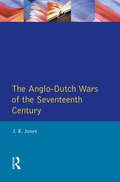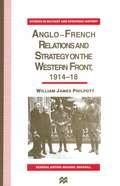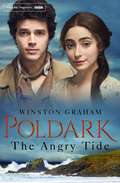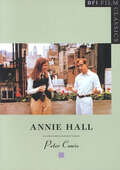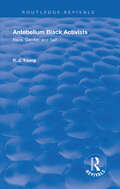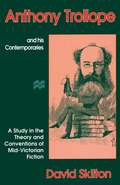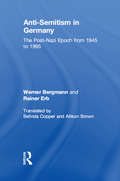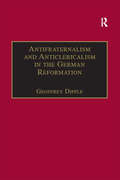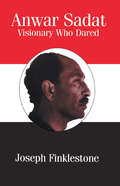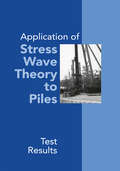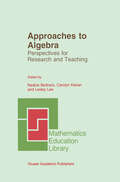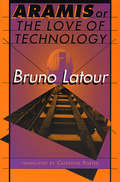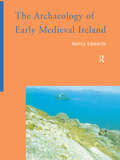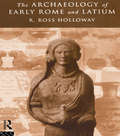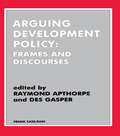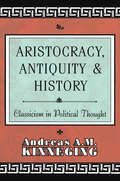- Table View
- List View
The Anglo-Dutch Wars of the Seventeenth Century
by J. R. JonesThis study of the Anglo--Dutch Wars (1652-54, 1665-67, 1672-74) sets them in their naval, political and economic contexts. Competing essentially over trade, both governments were crucially influenced by mercantile interests and by the representative institutions that were central to England and the Dutch Republic. Professor Jones compares the effectiveness of the governments under pressure - English with Dutch, Commonwealth with restored monarchy, Republican with Orangist - and the effects on their economies; and examines the importance of the wars in accelerating the formation of a professional officer corps and establishing battle tactics that would endure throughout the age of sail.
Anglo-French Relations and Strategy on the Western Front, 1914–18 (Studies in Military and Strategic History)
by William J. PhilpottThis book is a study of Anglo-French relations and military policy making in the First World War, which considers the strategic policies and operational planning of the British and French armies in the joint campaign fought on the western front. It examines the influence of incompatible British and French strategic objectives, the role of the allies' military and political leaders and the institutional development of the military alliance, on the alliance relationship and military policy making.
The Angry Tide: Cornwall - As The 18th Century Ebbs (Poldark #7)
by Winston GrahamThe basis of the fourth season of the television phenomenon starring Aidan Turner, The Angry Tide is the seventh novel in Winston Graham's hugely popular Poldark series.Cornwall, towards the end of the 18th century. Ross Poldark sits for the borough of Truro as Member of Parliament - his time divided between London and Cornwall, his heart divided about his wife, Demelza. His old feud with George Warleggan still flares - as does the illicit love between Morwenna and Drake, Demelza's brother. Before the new century dawns, George and Ross will be drawn together by a loss greater than their rivalry - and Morwenna and Drake by a tragedy that brings them hope . . .The Angry Tide is followed by the eighth book in the Poldark series, The Stranger From The Sea.
Annie Hall: A Nervous Romance (BFI Film Classics)
by Peter CowieFor an entire generation, 'Annie Hall 'embodied the notion of a New York peopled by sophisticated intellectuals - all sent up by the deadpan comedy genius of Woody Allen, writer, director and of course star. It also confirmed the sparkling acting talent of Diane Keaton as a partner for Woody on screen. The film has survived as a popular comedy, however, by virtue of Allen's inventiveness as a director and the timelessness of his satire. Peter Cowrie's study of 'Annie Hall 'recaptures the mood of the 70s, and examines the myriad imaginative touches that distinguish this film from other American productions of the period. The book also includes a glossary of the many cultural references which give the film its distinctively 'intellectual' tone.
Antebellum Black Activists: Race, Gender, and Self
by R. J. YoungFirst published in 1996. In this volume the author has collected several published works to explore the ideas of manhood in America, Sojourner Truth, ties of ordinary blacks to those still in slavery and a study of the Northern African American community; new information on black activities in Canada and begins with an essay on the five elements of black community activity before the Civil War: churches, newspapers, conventions, organizations, and emigration which looks at of these "platforms for change" going through developmental stages from experimentation, adjustment and reaching maturity in the 1850’s.
Antebellum Black Activists: Race, Gender, and Self
by R. J. YoungFirst published in 1996. In this volume the author has collected several published works to explore the ideas of manhood in America, Sojourner Truth, ties of ordinary blacks to those still in slavery and a study of the Northern African American community; new information on black activities in Canada and begins with an essay on the five elements of black community activity before the Civil War: churches, newspapers, conventions, organizations, and emigration which looks at of these "platforms for change" going through developmental stages from experimentation, adjustment and reaching maturity in the 1850’s.
Anthony Trollope and his Contemporaries: A Study in the Theory and Conventions of Mid-Victorian Fiction
by David SkiltonFirst published in 1972, the second edition of this highly respected classic of Trollope criticism will be welcomed by Trollope scholars everywhere. David Skilton examines the literary background against which Trollope wrote, and drawing on the vast evidence of mid-Victorian periodical criticism, he shows how this criticism controlled the novelist's creativity. He then goes on to examine Trollope's particular type of realism in the context of the theories of literary imagination current in the 1860s. 'A book I admire. It has been of great value to me.' - J. Hillis Miller 'The first and still the best study of Trollope's relationships, connections and interactions with the literary world of his own time. Skilton's is the necessary introduction to any serious investigation of Trollope's fiction.' - John Sutherland
Anti-Semitism in Germany: The Post-Nazi Epoch from 1945-95
by Rainer ErbThe surrender of Nazi Germany in 1945 marked the end of an epoch during which anti-Semitism escalated into genocide. In the immediate aftermath of World War II, Nazi racist ideology was discredited morally and politically, and the Allied occupation forces prohibited its dissemination in public. However, there was no overnight transformation of individual anti-Semitic attitudes among the public at large. Most surveys conducted since 1946 have confirmed the persistence of massive anti-Semitism in Germany both in the democratic West and the communist East. Based on all empirical survey data available up to now, this volume offers a thorough comparative analysis of anti-Semitism in Germany, and in particular its resurgence with the rise of right-wing extremism since unification.Anti-Semitism in Germany reflects a historically unique opportunity to compare the attitudes of two population groups that shared a common history up to 1945 and then lived under differing political conditions until 1989. The authors find distinct generational patterns in the survival and development of anti-Semitic attitudes. In the Federal Republic hostility towards Jews was more manifest among those who had been socialized to it under the Weimar Republic and Third Reich but less prevalent in subsequent generations. In contrast the authors show younger East Germans as more susceptible to anti-Semitism. The economic and cultural crises of reunification underwrote the strident anti-Zionism of the former communist regime. The authors also explore the anti-Semitic component of the recent wave of xenophobic violence and the disturbing rise of neo-Nazi political activity.This volume is especially noteworthy in its examination of a "secondary" anti-Semitism closely tied to the issue of coming to terms with the Nazi past. The motives behind persisting anti-Semitism can no longer be attributed to ethnic conflict, but go to the core discrepancy between wanting to forget and being reminded. The authors consider this phenomenon within the framework of current German political culture. In its comprehensiveness and methodological sophistication, Anti-Semitism in Germany is a major contribution to the literature on modern anti-Semitism and ethnic prejudice. It will be read by historians, political scientists, sociologists, and Jewish studies specialists.
Anti-Semitism in Germany: The Post-Nazi Epoch from 1945-95
by Werner Bergmann and Rainer ErbThe surrender of Nazi Germany in 1945 marked the end of an epoch during which anti-Semitism escalated into genocide. In the immediate aftermath of World War II, Nazi racist ideology was discredited morally and politically, and the Allied occupation forces prohibited its dissemination in public. However, there was no overnight transformation of individual anti-Semitic attitudes among the public at large. Most surveys conducted since 1946 have confirmed the persistence of massive anti-Semitism in Germany both in the democratic West and the communist East. Based on all empirical survey data available up to now, this volume offers a thorough comparative analysis of anti-Semitism in Germany, and in particular its resurgence with the rise of right-wing extremism since unification.Anti-Semitism in Germany reflects a historically unique opportunity to compare the attitudes of two population groups that shared a common history up to 1945 and then lived under differing political conditions until 1989. The authors find distinct generational patterns in the survival and development of anti-Semitic attitudes. In the Federal Republic hostility towards Jews was more manifest among those who had been socialized to it under the Weimar Republic and Third Reich but less prevalent in subsequent generations. In contrast the authors show younger East Germans as more susceptible to anti-Semitism. The economic and cultural crises of reunification underwrote the strident anti-Zionism of the former communist regime. The authors also explore the anti-Semitic component of the recent wave of xenophobic violence and the disturbing rise of neo-Nazi political activity.This volume is especially noteworthy in its examination of a "secondary" anti-Semitism closely tied to the issue of coming to terms with the Nazi past. The motives behind persisting anti-Semitism can no longer be attributed to ethnic conflict, but go to the core discrepancy between wanting to forget and being reminded. The authors consider this phenomenon within the framework of current German political culture. In its comprehensiveness and methodological sophistication, Anti-Semitism in Germany is a major contribution to the literature on modern anti-Semitism and ethnic prejudice. It will be read by historians, political scientists, sociologists, and Jewish studies specialists.
Antifraternalism and Anticlericalism in the German Reformation: Johann Eberlin von Günzburg and the Campaign Against the Friars (St Andrews Studies in Reformation History)
by Geoffrey DippleMany of the leading figures of the Reformation and many of their most able opponents came from among the ranks of the Franciscan Order. This Order became the focus of attack in a pamphlet war waged against it in 1523 by converts to the Reformation. These criticisms were based on arguments by Luther in his Judgement on Monastic Vows, and the pamphlets provided an important channel for these views. Luther’s arguments were also reinforced by criticisms of the mendicant orders drawn from medieval polemical and satirical literature. The campaign of 1523 brought together both Reformation and pre-Reformation anticlerical themes. In this book Geoffrey Dipple looks at the perception of the Franciscan order in the 15th and 16th centuries, placing the attacks firmly in the context of late medieval inter-clerical rivalries. He looks particularly at the anticlerical polemics of one of the primary participants - Johann Eberlin von Günzburg - the most vocal of the Franciscan’s critics.
Antifraternalism and Anticlericalism in the German Reformation: Johann Eberlin von Günzburg and the Campaign Against the Friars (St Andrews Studies in Reformation History)
by Geoffrey DippleMany of the leading figures of the Reformation and many of their most able opponents came from among the ranks of the Franciscan Order. This Order became the focus of attack in a pamphlet war waged against it in 1523 by converts to the Reformation. These criticisms were based on arguments by Luther in his Judgement on Monastic Vows, and the pamphlets provided an important channel for these views. Luther’s arguments were also reinforced by criticisms of the mendicant orders drawn from medieval polemical and satirical literature. The campaign of 1523 brought together both Reformation and pre-Reformation anticlerical themes. In this book Geoffrey Dipple looks at the perception of the Franciscan order in the 15th and 16th centuries, placing the attacks firmly in the context of late medieval inter-clerical rivalries. He looks particularly at the anticlerical polemics of one of the primary participants - Johann Eberlin von Günzburg - the most vocal of the Franciscan’s critics.
Anwar Sadat: Visionary Who Dared
by Joseph Finklestone Joseph Finklestone ObeAnwar Sadat's life was shaped by Egypt's national struggle and the conflict between the Arab world and Israel. This biography charts his progress from fanatical nationalist to President of Egypt, and from world statesman to tragic hero, who gave his life in the cause of peace.
Anwar Sadat: Visionary Who Dared
by Joseph Finklestone Joseph Finklestone ObeAnwar Sadat's life was shaped by Egypt's national struggle and the conflict between the Arab world and Israel. This biography charts his progress from fanatical nationalist to President of Egypt, and from world statesman to tragic hero, who gave his life in the cause of peace.
Application of Stress Wave Theory to Piles: Proceedings of the 14th International Conference on the Application of Stress-Wave Theory to Piles, The Hague, Netherlands, 21-24 September 1992
by Frans B. J. BarendsThis volume presents the Pile Testing Research Project, and covers most of the results. Topics include: general soil conditions of the test site; pile integrity tests; pile driving prediction contest; pile driving demonstration; and vibratory pile driving techniques.
Application of Stress Wave Theory to Piles: Proceedings of the 14th International Conference on the Application of Stress-Wave Theory to Piles, The Hague, Netherlands, 21-24 September 1992
by Frans B.J. BarendsThis volume presents the Pile Testing Research Project, and covers most of the results. Topics include: general soil conditions of the test site; pile integrity tests; pile driving prediction contest; pile driving demonstration; and vibratory pile driving techniques.
Approaches to Algebra: Perspectives for Research and Teaching (Mathematics Education Library #18)
by N. Bednarz C. Kieran L. LeeIn Greek geometry, there is an arithmetic of magnitudes in which, in terms of numbers, only integers are involved. This theory of measure is limited to exact measure. Operations on magnitudes cannot be actually numerically calculated, except if those magnitudes are exactly measured by a certain unit. The theory of proportions does not have access to such operations. It cannot be seen as an "arithmetic" of ratios. Even if Euclidean geometry is done in a highly theoretical context, its axioms are essentially semantic. This is contrary to Mahoney's second characteristic. This cannot be said of the theory of proportions, which is less semantic. Only synthetic proofs are considered rigorous in Greek geometry. Arithmetic reasoning is also synthetic, going from the known to the unknown. Finally, analysis is an approach to geometrical problems that has some algebraic characteristics and involves a method for solving problems that is different from the arithmetical approach. 3. GEOMETRIC PROOFS OF ALGEBRAIC RULES Until the second half of the 19th century, Euclid's Elements was considered a model of a mathematical theory. This may be one reason why geometry was used by algebraists as a tool to demonstrate the accuracy of rules otherwise given as numerical algorithms. It may also be that geometry was one way to represent general reasoning without involving specific magnitudes. To go a bit deeper into this, here are three geometric proofs of algebraic rules, the frrst by Al-Khwarizmi, the other two by Cardano.
Aramis, or the Love of Technology
by Bruno LatourBruno Latour has written a unique and wonderful tale of a technological dream gone wrong. As the young engineer and professor follow Aramis' trail--conducting interviews, analyzing documents, assessing the evidence--perspectives keep shifting: the truth is revealed as multilayered, unascertainable, comprising an array of possibilities worthy of Rashomon. The reader is eventually led to see the project from the point of view of Aramis, and along the way gains insight into the relationship between human beings and their technological creations. This charming and profound book, part novel and part sociological study, is Latour at his thought-provoking best.
The Archaeology of Early Medieval Ireland
by Nancy EdwardsIn the first major work on the subject for over 30 years, Nancy Edwards provides a critical survey of the archaeological evidence in Ireland (c. 400-1200), introducing material from many recently discovered sites as well as reassessing the importance of earlier excavations. Beginning with an assessment of Roman influence, Dr Edwards then discusses the themse of settlement, food and farming, craft and technology, the church and art, concluding with an appraisal of the Viking impact. The archaeological evidence for the period is also particularly rich and wide-ranging and our knowledge is expanding repidly in the light of modern techniques of survey and excavation.
The Archaeology of Early Medieval Ireland
by Nancy EdwardsIn the first major work on the subject for over 30 years, Nancy Edwards provides a critical survey of the archaeological evidence in Ireland (c. 400-1200), introducing material from many recently discovered sites as well as reassessing the importance of earlier excavations. Beginning with an assessment of Roman influence, Dr Edwards then discusses the themse of settlement, food and farming, craft and technology, the church and art, concluding with an appraisal of the Viking impact. The archaeological evidence for the period is also particularly rich and wide-ranging and our knowledge is expanding repidly in the light of modern techniques of survey and excavation.
The Archaeology of Early Rome and Latium
by Ross R. HollowayThe archaeology of early Rome has progressed rapidly and dramatically over the last century; most recently with the discovery of the shrine of Aeneas at Lavinium and the reports of the walls of the Romulan city discovered on the city slopes of the Palatine Hill. The Archaeology of Early Rome and Latium presents the most recent discoveries in Rome and its surroundings: princely tombs,inscriptions and patrician houses are included in a complete overview of the subject and the controversies surrounding it.This comprehensively illustrated study fills the need for an accessible English guide to these new discoveries, and in preparation, the author interviewed most of the leading figures in current research on the early periods of Rome.
The Archaeology of Early Rome and Latium
by Ross R. HollowayThe archaeology of early Rome has progressed rapidly and dramatically over the last century; most recently with the discovery of the shrine of Aeneas at Lavinium and the reports of the walls of the Romulan city discovered on the city slopes of the Palatine Hill. The Archaeology of Early Rome and Latium presents the most recent discoveries in Rome and its surroundings: princely tombs,inscriptions and patrician houses are included in a complete overview of the subject and the controversies surrounding it.This comprehensively illustrated study fills the need for an accessible English guide to these new discoveries, and in preparation, the author interviewed most of the leading figures in current research on the early periods of Rome.
Arguing Development Policy: Frames and Discourses
by Raymond Apthorpe Des GasperThis collection shows how policy discourses in the fields of national and international developments are constructed and operate and how they can be analysed. Dominant discourses screen out certain aspects: they frame' issues to include some matters and typically exclude important others. More generally, different policy discourses construct the world in distinctive ways, through language that requires deconstruction and careful review.
Arguing Development Policy: Frames and Discourses
by Raymond Apthorpe Des GasperThis collection shows how policy discourses in the fields of national and international developments are constructed and operate and how they can be analysed. Dominant discourses screen out certain aspects: they frame' issues to include some matters and typically exclude important others. More generally, different policy discourses construct the world in distinctive ways, through language that requires deconstruction and careful review.
Aristocracy, Antiquity and History: Classicism in Political Thought
by Andreas KinnegingThis brilliant critique of the literature on modernity challenges conventional approaches in two fundamental ways: First, the lineage of the modern turns out to be less ancient and glorious than is usually suggested. Modernity is an upstart rather than a scion of an old and celebrated line. The roots of modernity are held to be less secure than previously thought. This leads the author to suggest that the demise of the old is a matter of rhetoric rather than reality. The old was driven underground rather than extinguished. The inherited traditions are deeply embedded in our souls. We turn to modernity as a half-baked worldview to overcome our estrangement from the past.Kinneging examines this sweeping view in the concrete circumstances of the imagined fall of the aristocracy and rise of the enterprising bourgeoisie. But aristocracy, this study reveals a strong and thriving noblesse, not only in places like Russia and Prussia, but also in advanced capitalist states like France and England. Aristocracy, Antiquity, and History shows conclusively that the actual demise of this exploration into the sources of Western thought takes seriously the strength of an aristocratic vision that lives on in a variety of conservative and liberal doctrines.In Aristocracy, Antiquity and History the readers is reacquainted with the democratic potential as in the work of Montesquieu, and the way in which classicism, romanticism, and modernism, far from a sequential set of events, are entwined in the ethic of honor and in the moral order of modern life. In trying to understand modernity, advanced societies cannot help but draw attention to the old by way of contrast. The presence of antiquity, however suppressed or shrugged off, does not disappear, but stays with us in the very act of rebellion against the ancients. This fine work in the history of ideas will serve to redefine and redirect researches in social and political theory for years to come.
Aristocracy, Antiquity and History: Classicism in Political Thought
by Andreas KinnegingThis brilliant critique of the literature on modernity challenges conventional approaches in two fundamental ways: First, the lineage of the modern turns out to be less ancient and glorious than is usually suggested. Modernity is an upstart rather than a scion of an old and celebrated line. The roots of modernity are held to be less secure than previously thought. This leads the author to suggest that the demise of the old is a matter of rhetoric rather than reality. The old was driven underground rather than extinguished. The inherited traditions are deeply embedded in our souls. We turn to modernity as a half-baked worldview to overcome our estrangement from the past.Kinneging examines this sweeping view in the concrete circumstances of the imagined fall of the aristocracy and rise of the enterprising bourgeoisie. But aristocracy, this study reveals a strong and thriving noblesse, not only in places like Russia and Prussia, but also in advanced capitalist states like France and England. Aristocracy, Antiquity, and History shows conclusively that the actual demise of this exploration into the sources of Western thought takes seriously the strength of an aristocratic vision that lives on in a variety of conservative and liberal doctrines.In Aristocracy, Antiquity and History the readers is reacquainted with the democratic potential as in the work of Montesquieu, and the way in which classicism, romanticism, and modernism, far from a sequential set of events, are entwined in the ethic of honor and in the moral order of modern life. In trying to understand modernity, advanced societies cannot help but draw attention to the old by way of contrast. The presence of antiquity, however suppressed or shrugged off, does not disappear, but stays with us in the very act of rebellion against the ancients. This fine work in the history of ideas will serve to redefine and redirect researches in social and political theory for years to come.
